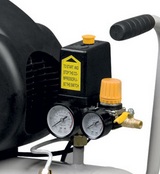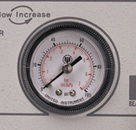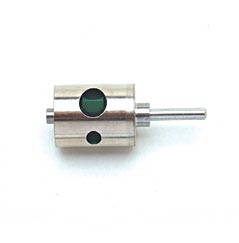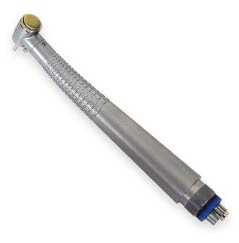|
March 2013
Dr Gerhard Steenkamp
Twenty years ago the standard in practices was to have a dental scaler and an electric motor with
an E-type fitting. This motor was then able to drive a polishing handpiece (contra-angle
handpiece). The latter was then often also used to section teeth by using drill bits with a latch
type fitting.
Electric motors usually run at 20,000 revolutions per minute (rpm), but today this can go up to
40,000 rpm. The advantage of these motors is that they have high torque, but at the cost of being
rather slow.
Air driven dental units are becoming more popular in most veterinary practices. Meaning they are
driven by compressed air that is stored in a high pressure tank connected to a motor that generates
this compression. Generally there are 2 types of compressors available, oiled and oil free
compressors. Oiled compressors are the general use compressors that we all know from household
chores like inflating our tyres, spray painting and so on. The compressors are quite loud. Silent
air compressors are named such as the noise level is much reduced. The motors used on these
machines are similar to fridge motors which are quite silent. Most dental practices will have these
built into their consulting rooms.
In both the compressors oil is used to a greater (Oiled compressors) or lesser (silent air
compressors) extent. It is crucial to make sure that no oil is transferred from the reservoir tank
into the airline that is connected to a handpiece that could ultimately blow this oil containing
air onto the patient’s tissues. Oil filters/traps can be used in-line to reduce the risk of the
latter happening. It is very important that the filter used is specified to remove oil and water
and that it is regularly inspected and drained when necessary.
Having supplied quite a number of dental units into the South African market over the past 10
years, I have decided to address some of the common mistakes we have seen in the maintenance of
this equipment in the hands of veterinarians and their staff.
Pressure
The information above was provided to make you more aware of the very basic mechanics of an air
driven dental unit.
The pressure in the reservoir tank is regulated so that the motor will cut out when tank pressure
reaches 8 bar (101 psi). As the air is drained out of the tank, the motor will kick in to keep the
pressure constant.

All new compressors are fitted with 2 pressure regulators 1 for the tank and the other for the
outlet pressure. The 2nd regulator is set to regulate the outgoing air. The pressure required to
drive an air turbine (high speed handpiece) is 3 bar (29 psi). In most units the outgoing air
pressure is to be set between 4 and 6 bar (43 - 72 psi). If the distance from the compressor and
the dental unit is very short, or if a tubing with a larger diameter is used to deliver the air to
the dental unit, the regulator could be dialled even further down to 3 bar (29 psi). Once the
regulator is correctly set, use the locking nut to lock it into place. This will prevent accidental
turning of the dial which may increase or decrease the pressure.

If the pressure to the turbine is higher than 3 bar (29 psi), the
turbine on the handpiece will have revolutions in excess of recommend running speed. This will
increase the friction between the bearings in the turbine and will lead to early failure of the
turbine. Conversely, if a very low pressure is used, the turbine will not be able to generate
enough speed to cut effectively. This may increase the pressure the operator places on the drill
bit and again back onto the turbine. This could also increase the workload of the bearings and once
again will lead to early failure.
Always make sure that once the pedal is completely compressed to
deliver air to the handpieces that the dial on the unit does not exceed 3 bar (29 psi).
Other causes of turbine
failure

A high speed handpiece without its turbine is referred to as a
“shell” as without the turbine it will
not/ cannot operate.
The turbine contains ball bearings in the head, which rotate the drill once it is inserted.
Apart from pressure, the most important other aspect of turbine care is regular oiling. We
recently serviced a unit where the turbine was regularly oiled, but no regulator was placed
on the compressor. It lasted a year, running at 8 bar (101 psi). This is a testament to a
very good turbine!

Fast handpieces should be oiled after each use
with a minimum oiling at the end of every day if the handpiece was used. Clean it thoroughly with a
disinfecting solution and oil it by instilling handpiece oil into the compartments as specified by your supplier. Do not forget to also squirt some oil
into the clasps of the canister that holds the bur in place. Let the turbine stand upside down for
about 2 minutes and then re-attach to the unit, letting it run for 30 seconds to 1 minute with no
water. This is done to remove all excess oil in the turbine. It is now ready for autoclaving and
future use.
Extending burrs in the canister. Some clinicians may feel the need to
remove the bur slightly out of the canister thereby extending the length of the bur. This is
commonly done when sectioning large molar and premolar teeth of large breed dogs. The danger here
is that as soon as the bur is extended, the balance of the bur in the cartridge is distorted and
hence the bur may start to oscillate instead of running in a smooth balanced plane. This again
places tremendous strain on the turbine and may result in early failure of it.
Next time I will give more information on how air driven units
function as well as care for the air motor and contra-angle handpieces.
|
